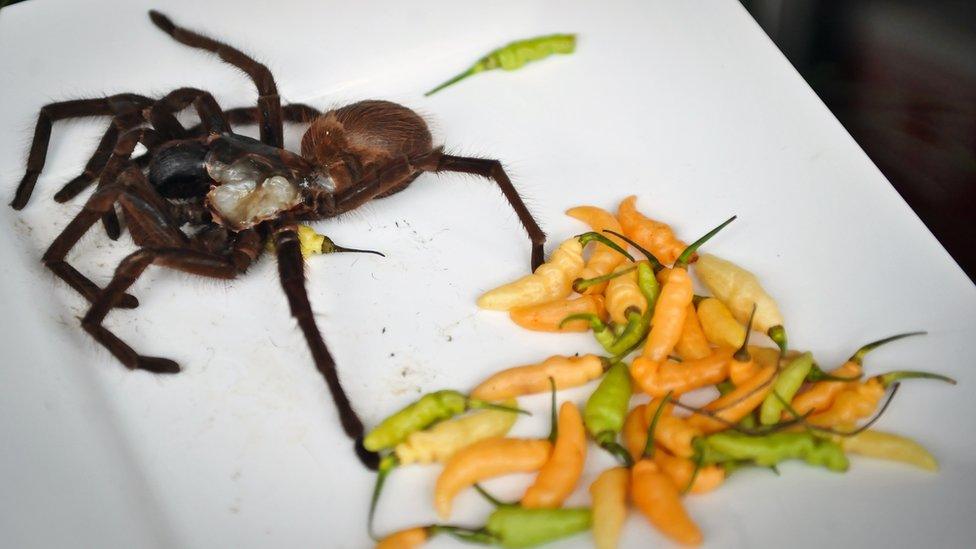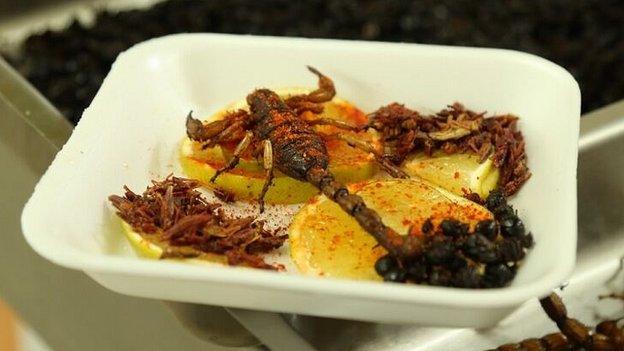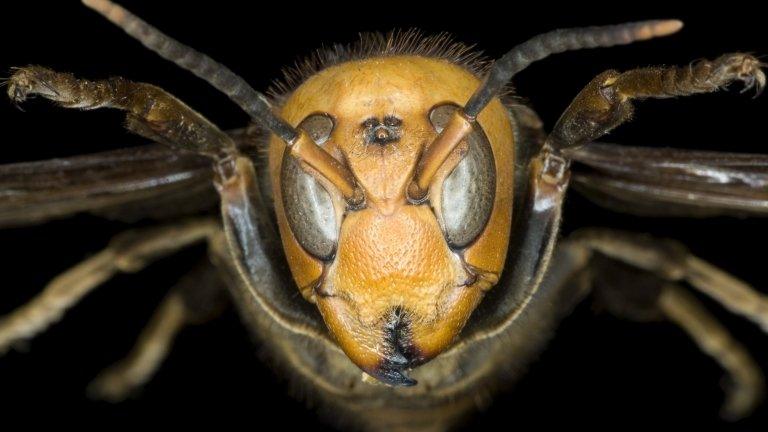Should we eat bugs like Angelina Jolie?
- Published
Angelina Jolie taught Yalda Hakim how to cook bugs in Cambodia
Angelina Jolie cooked up a storm while promoting her latest film in Cambodia by eating bugs with her kids.
The actress was seen frying a scorpion and eating the leg of a spider which she said had a "really good flavour".
Eating creepy crawlies has been long associated with the TV show I'm a Celebrity... Get Me Out Of Here.
But should we all be more like Angelina and swap our bacon for bugs?
Why should we eat more creepy crawlies?

It's estimated that by 2050 the world will be home to nine billion people, meaning current food production will need to almost double.
As the population grows, there's been a real push to look at sources of food - particularly protein - other than your traditional meat and fish.
Eating insects is said to be one way of meeting this challenge because they are environmentally sustainable, nutritious and can be harvested relatively cheaply and easily in the right conditions.
Why don't we in the UK eat bugs already?
It's estimated that two billion people worldwide eat insects as part of their traditional diet, but Western countries have yet to catch up.
There is a "yuck factor", says the Waste and Resources Action Programme (WRAP), external. It says Western attitudes towards entomophagy - humans eating insects - are negative because bugs are seen as unclean and disease-carrying.
The rise of agriculture and a change in lifestyle in Western societies has also led to insects being seen as "pests", says the Food and Agriculture Organization of the United Nations (FAO), external.
Mosquitoes and flies invade homes and bite, termites destroy wood, and some insects end up as unwanted extras in restaurant meals - all of which trigger a "disgust" reaction, it added.
However, there has been a slow shift in attitudes with the art of eating bugs being considered a novelty, which has seen a rise in their purchase as an unusual gift.
What are the benefits of eating insects?

Insects can be sprinkled onto pizza as a topping
"They are the original superfood," says Shami Radia, co-founder of Grub , externalwhich sells a range of edible bugs. "They are high in protein, minerals and amino acids so it makes sense to eat them."
Insects are also better for the environment than conventional livestock farming. They can feed on bio-waste, produce less greenhouse gases, use less water and take up less land than animals.
Bugs also have what's called a high feed conversion efficiency because they are cold-blooded. On average, insects can convert 2kg of feed into 1kg of insect mass, whereas cattle require 8kg of feed to produce 1kg of body weight gain.
What kind of bugs can you eat?
There are around 1,900 different species of insects that have been used as food, according to the FAO.
The most commonly eaten insect groups include beetles, caterpillars, bees, wasps, ants, grasshoppers, locusts, crickets, termites, dragonflies and flies.
Despite such a variety of insects being available though, UK suppliers have focused on a more limited choice with the most popular being crickets, mealworms, locusts and grasshoppers.
What about eating a spider like Angelina?

Grub sellers believe the UK is a long way from embracing spiders and scorpions on our dinner plate.
"We have to take baby steps," says Mr Radia. "It's not something we would sell. You've got to think about what insects to push and what will get people into eating grubs.
"You have to think of the consumer journey. You can start off with cricket powder because you can't actually see the insect and hopefully it will make people more comfortable with eating insects as a whole."
So far, the UK market has seen pop-up shops and restaurants incorporate insects into more traditional dishes such as buffalo worm macaroni cheese, meal worm bolognaise, chocolate cherry cricket brownies or sprinkled on a pizza.
They are also marketed as an on-the-go snack that would sit alongside your roasted peanuts or chia seeds.
Is there a demand for eating insects in the UK?
Bug sellers say there has been a real shift in the popularity of edible bugs.
Nick Cooper, owner of Crunchy Critters, external which was set up in 2012, has seen a sales growth rate of 25% year on year with products being sold to schools as well as gyms. He notes there is a particular boom around Halloween and the festive period.
"People are much more aware of eating insects," he said. "There's not that shock horror factor now. The market is definitely heading in the right direction. It won't be an overnight change and will probably be led in the future by youngsters."
Mr Radia believes that eating insects will one day become as popular as eating sushi.
"Behaviour can be changed," he said. "Prawns are ugly and taste delicious and there's no reason why eating insects can't be normalised."
- Published16 September 2016

- Published8 October 2015

- Published11 December 2015
